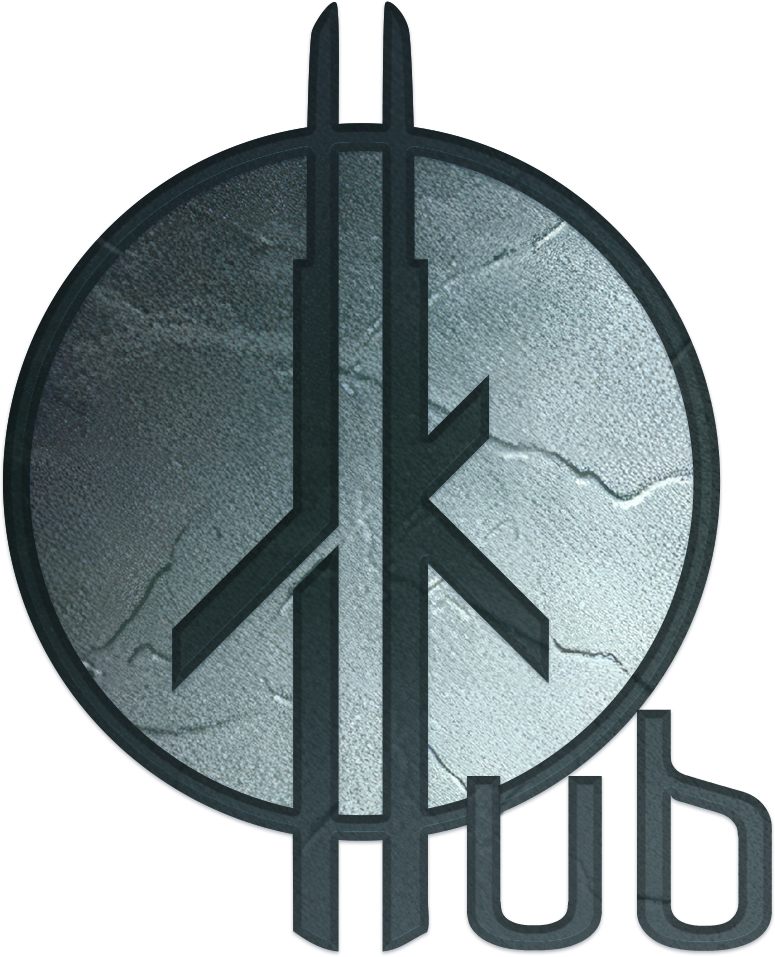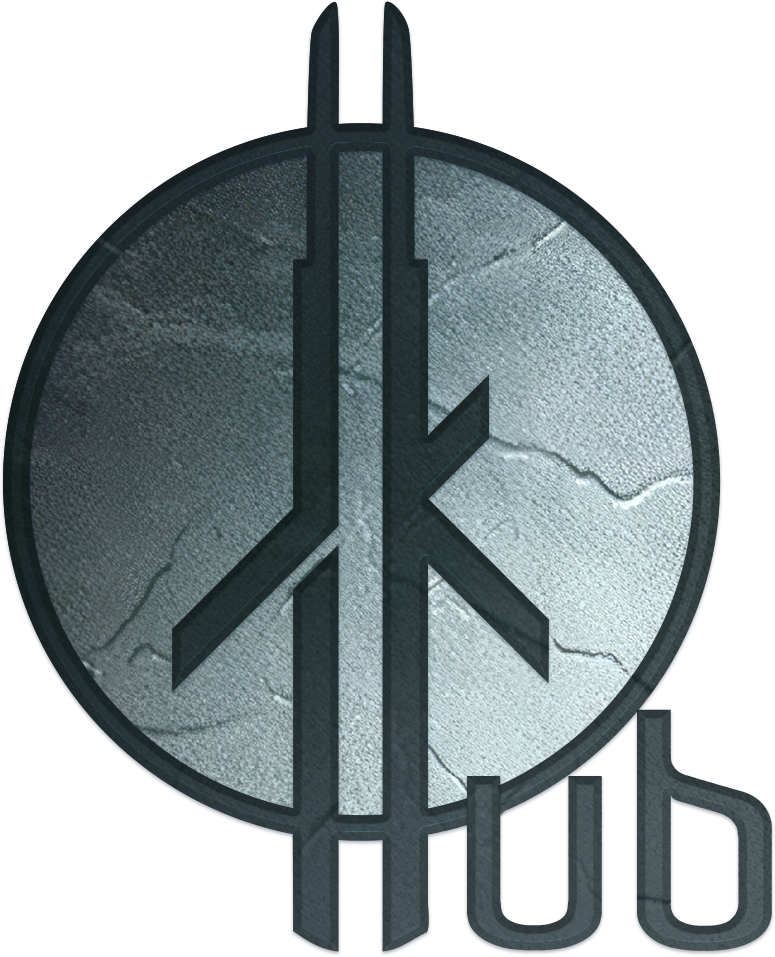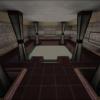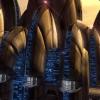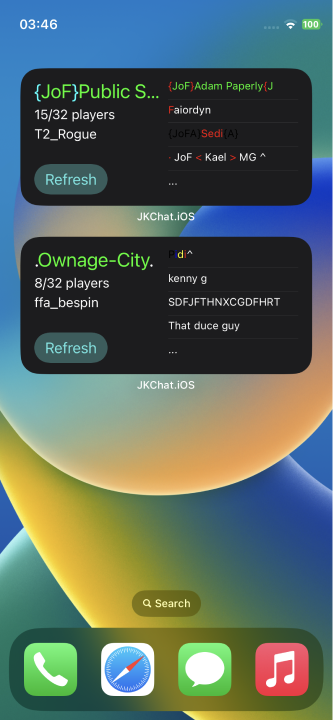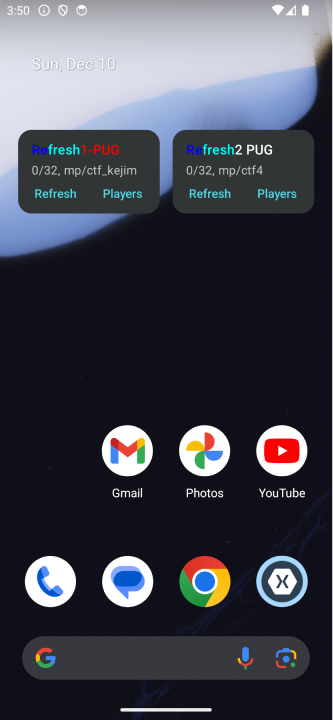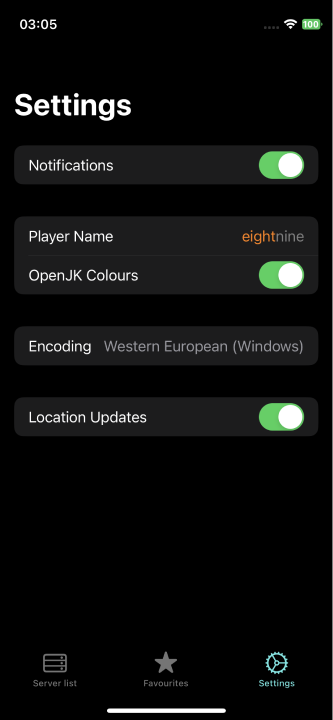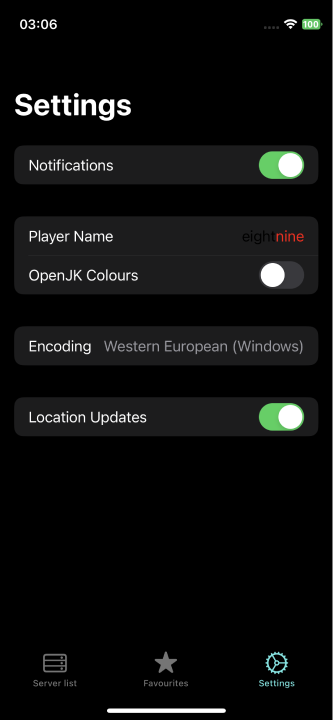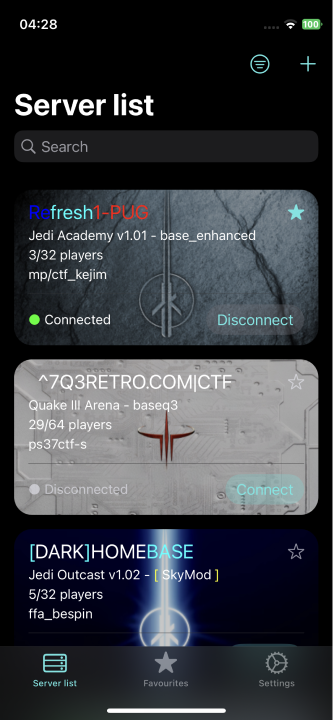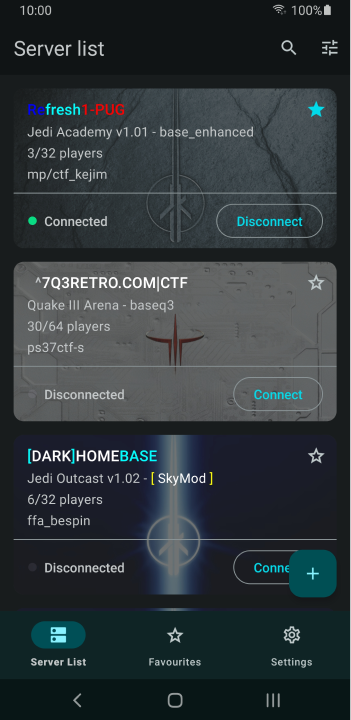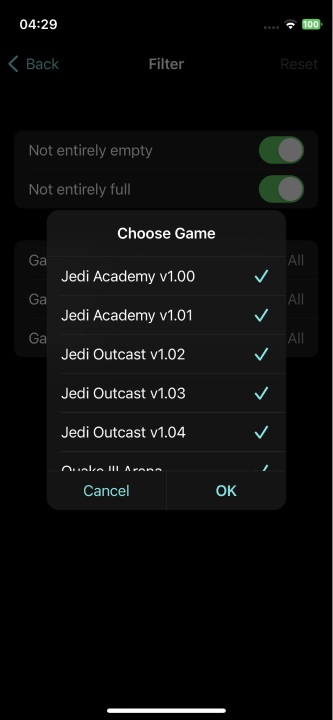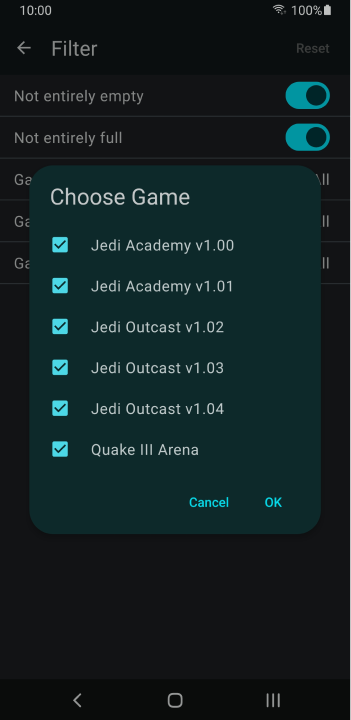-
Posts
551 -
Joined
-
Last visited
Profile Information
-
Gender
Not Telling
-
Modding Interests
Coder
Shaders
General Modding -
Gaming Specialty
Competitive Play
Capture the Flag
Speedrunning -
Operating System
Windows 7
Recent Profile Visitors
3,479 profile views
ent's Achievements
-
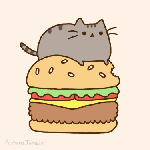
JKChat A.K.A. Jedi Knight mobile application
ent replied to ent's topic in Jedi Knight General Discussions
A smol update: - added date and time of the last widget refresh Redownload. The links are the same. -
Smoo liked a post in a topic: JKChat A.K.A. Jedi Knight mobile application
-
Smoo liked a post in a topic: JKChat A.K.A. Jedi Knight mobile application
-

JKChat A.K.A. Jedi Knight mobile application
ent replied to ent's topic in Jedi Knight General Discussions
iOS version with Widgets got approved and available on TestFlight. -
Circa liked a post in a topic: JKChat A.K.A. Jedi Knight mobile application
-

JKChat A.K.A. Jedi Knight mobile application
ent replied to ent's topic in Jedi Knight General Discussions
Updated the app. For iOS users: Install TestFlight: https://apps.apple.com/app/testflight/id899247664 Then open that link on your iOS device: https://testflight.apple.com/join/5HSqhVHw For Android users: Install directly from APK: https://www.dropbox.com/s/ptx301a1pas39n9/com.vlbor.jkchat.apk?dl=1 Install from Google Play: https://play.google.com/store/apps/details?id=com.vlbor.jkchat Changed: - added server monitor widgets - added push notifications - added light theme - added applied filter indicator - added OpenJK colours option - made filter lists order by selected - made dialogs with input autofocus - fixed crash after restoration on Android - fixed time font size in Chat on iOS Added Widgets to monitor favourite servers without opening the app or special server monitoring sites. The idea of home screen Widgets visited me pretty much long ago but I was "scared" to add it since I've never worked with Widgets before. But here they are so I faced my "fear". To add Widgets follow official instructions: https://support.apple.com/en-gb/HT207122 for iOS and https://support.google.com/android/answer/9450271?hl=en#zippy=%2Cadd-or-resize-a-widget for Android. To add a server for monitoring into a Widget you first have to add that server in Favourites in the JKChat app. To do so you need to filter out or search the needed server in Server List, tap on Star icon in the server card. Once you added the server you can go to your added Widget to edit it to monitor your special server. Android: tap on the widget and select the server to monitor from the list (Favourites). To refresh the list click Refresh button. To see players list click Players button. iOS: long tap on the widget, tap Edit Widget, tap Choose server, and select the server to monitor from the list (Favourites). To refresh the list click Refresh button. You can use middle and large sized Widgets to monitor players list as well. Tapping on the Widget with a server will navigate you to the app and open Server Info of that server. If you want to connect to the server or just open the app without any navigation you can select corresponding options in Settings. Widgets UI is made by me (comparing to the app UI by my wife) so they are not that pretty. Maybe they will look better in the future. I also properly implemented push notifications. They get triggered when you are connected to a server. Current triggers are: a player connects, you receive a private message, or a chat message contains keywords. All those things are configurable through Settings/Notifications. Tapping on a push notification will navigate you the chat. And the last highlight feature is themes. It is experimental or just proof of concept so don't expect much please. If you follow Apple and Google development guidelines (and I followed) then your Light and Dark themes can work out of the box. So basically I just enabled that was already available. Light theme is not adjusted to game colours so white colours can look invisible. If you encounter any error, then please report me either in the feedback form in TestFlight or in this JKHub post or in JKHub PM or on discord PM: ent#9404. Report the error either by copying it or taking a screenshot and showing me or just telling the steps to reproduce. Thanks. -
Smoo liked a post in a topic: JKChat A.K.A. Jedi Knight mobile application
-
Circa liked a post in a topic: JKChat A.K.A. Jedi Knight mobile application
-

JKChat A.K.A. Jedi Knight mobile application
ent replied to ent's topic in Jedi Knight General Discussions
@Circa Hi. I like options. Currently done like this, maybe it will look a bit different in the next release. Need more requests or bug reports - the app cannot be so well made in the latest release! x) -
ent liked a post in a topic: JKChat A.K.A. Jedi Knight mobile application
-
Smoo liked a post in a topic: JKChat A.K.A. Jedi Knight mobile application
-

JKChat A.K.A. Jedi Knight mobile application
ent replied to ent's topic in Jedi Knight General Discussions
Updated iOS app: - fixed incorrectly working Favourites - fixed wrong fonts in chat - fixed backgrounds in server info and chat - fixed never saving filters Redownload the app. Links are the same. -
Cor liked a post in a topic: JKChat A.K.A. Jedi Knight mobile application
-
Circa liked a post in a topic: JKChat A.K.A. Jedi Knight mobile application
-
Smoo liked a post in a topic: JKChat A.K.A. Jedi Knight mobile application
-

JKChat A.K.A. Jedi Knight mobile application
ent replied to ent's topic in Jedi Knight General Discussions
Updated the app. For iOS users: Install TestFlight: https://apps.apple.com/app/testflight/id899247664 Then open that link on your iOS device: https://testflight.apple.com/join/5HSqhVHw For Android users: Install directly from APK: https://www.dropbox.com/s/ptx301a1pas39n9/com.vlbor.jkchat.apk?dl=1 Install from Google Play: https://play.google.com/store/apps/details?id=com.vlbor.jkchat Changed: - changed visual appearance on Android: it now follows Google Material Design 3 (Material You) guidelines - changed visual appearance on iOS: it now follows Apple Design guidelines (HIG) - added filters - added favourites - added detailed server information including scoreboard and server cvars - added commands suggestions None expected but here it is. JKChat in a new shell with a lot of new features. The main feature is probably visual appearance. In the first version we decided to stylize the app with Jedi Academy colours and fonts. But then the app extended games support to Jedi Outcast and Quake III. So we decided to go with neutral appearance. And each platform provides what we needed. So we went wtih Material Design 3 on Android and Apple Design on iOS. Each of of those give us the ability to switch between light and dark themes, customize accent colour and support of accessibility features. Hope you like the new look. Current switching themes is not implemented (but it works!) since some colours has to be adjusted but it will appear in the near future for sure. Another long awaited feature is server list filters. You can choose to exclude empty or full servers, choose games, their mods and game types. And additionally to that you can add servers to favourites to not bother with filters at all or do that once. Also we added server full information page where you can see scoreboard and server cvars, or share the server with others. And for those who likes to use commands in the game we added a "/" (slash) button in chat page with commands suggestions. There are only few commands as proof of concept but feel free to suggest more depending on a mod (like JA+ commands etc). All those features were done in a hurry and not well tested, so please test and leave your feedback so I can fix all the bugs asap. If you encounter any error, then please report me either in the feedback form in TestFlight or in this JKHub post or in JKHub PM or on discord PM: ent#9404. Report the error either by copying it or taking a screenshot and showing me or just telling the steps to reproduce. Thanks. -
Smoo liked a post in a topic: JKChat A.K.A. Jedi Knight mobile application
-

JKChat A.K.A. Jedi Knight mobile application
ent replied to ent's topic in Jedi Knight General Discussions
Updated the app. For iOS users: Install TestFlight: https://apps.apple.com/app/testflight/id899247664 Then open that link on your iOS device: https://testflight.apple.com/join/5HSqhVHw For Android users: Install directly from APK: https://www.dropbox.com/s/ptx301a1pas39n9/com.vlbor.jkchat.apk?dl=1 Install from Google Play: https://play.google.com/store/apps/details?id=com.vlbor.jkchat Changed: - added a possibility to search in server list page - added a possibility to preview nickname in settings page - added a setting to set encoding for Jedi Academy in settings page - some fixes to properly run the iOS app on macOS on Apple Silicon After trying the application, please, leave a feedback of what you'd like see in the future. Yes, you can request any feature you want. It's not necessarily to be only limited to chat, I could implement other game features. Probably everything is possible that doesn't require game assets. Also if you encounter any error, then please report me either in the feedback form in TestFlight or in this JKHub post or in JKHub PM or on discord PM: ent#9404. Report the error either by copying it or taking a screenshot and showing me or just telling the steps to reproduce. -

JKChat A.K.A. Jedi Knight mobile application
ent replied to ent's topic in Jedi Knight General Discussions
The app got released on Apple App Store so it will never expire in 3 month like it does on TestFlight: https://apps.apple.com/app/jkchat/id1545850673 -

JKChat A.K.A. Jedi Knight mobile application
ent replied to ent's topic in Jedi Knight General Discussions
You are close to the idea we got as well: @TriForce -
ent liked a post in a topic: JKChat A.K.A. Jedi Knight mobile application
-

JKChat A.K.A. Jedi Knight mobile application
ent replied to ent's topic in Jedi Knight General Discussions
Updated the app. For iOS users: Install TestFlight: https://apps.apple.com/app/testflight/id899247664 Then open that link on your iOS device: https://testflight.apple.com/join/5HSqhVHw For Android users: Install directly from APK: https://www.dropbox.com/s/ptx301a1pas39n9/com.vlbor.jkchat.apk?dl=1 Install from Google Play: https://play.google.com/store/apps/details?id=com.vlbor.jkchat Changed: - added a possibility to add a server manually by IP or URL ("+" button on the screenshots) - fixed crashes or undefined behaviour when restoring the app from suspension on Android - fixed appearance on iOS 16 - fixed freezes on launch with bad internet connection After trying the application, please, leave a feedback of what you'd like see in the future. Yes, you can request any feature you want. It's not necessarily to be only limited to chat, I could implement other game features. Probably everything is possible that doesn't require game assets. Also if you encounter any error, then please report me either in the feedback form in TestFlight or in this JKHub post or in JKHub PM or on discord PM: ent#9404. Report the error either by copying it or taking a screenshot and showing me or just telling the steps to reproduce. -
1. Introduction Hello all! Today I'm gonna tell you a bit more about different blur styles and settings that you can use in jaMME. Hopefully it will help you pick the right settings for your material. As you probably know, there are several commands which affect the way mme will blur your frames. Those are: mme_blurframes [0-32] mme_bluroverlap [0-32] mme_blurtype [gaussian,triangle,median] mme_blurframes determines the amount of frames that is taken into the blending. the bigger the number, more smooth the final image is, but also longer processing is required. mme_bluroverlap is similar to blurframes, but it is the number of frames that are kept from previous frame and blended into the new frame. higher number results in smoother image. mme_blurtype governs the algorithm of the smoothing. The tutorial is divided in few sections. Hope you'll enjoy it. 2. Theory In case you are not interested in the beneath the hood part, you may skip to next section, but at least check the "in short" part. This will get slightly mathematical and all. First lets say a bit on different blur shapes. Triangle It is the simplest of blurring methods. It uses the linear average between multiple pixels. It is what is more commonly referred to as mean average. Mathematics: Example 1: (2 + 4 + 3 + 11) / 4 = 5. Example 2: (2 + 4 + 3 + 111) / 4 = 40. Store all pixel data into a 3d matrix, with width [x] and height [y] the size of a single image and "length" [z] of the mme_blurframes. For each [x,y] calculate the linear average of all [z]. That is your new image. Example 1: We have only one gray-scale pixel over 4 frames, with values of 0 (black) - 255 (white). [0,100,5,255] -> [(0+100+5+255)/4] -> [90] As a result we have a dark gray pixel. Example 2: We have only one gray-scale pixel over 5 frames with values of 0 (black) - 255 (white). [0,0,0,0,250] -> [(0+0+0+0+250)/5] -> [50] As above examples show extreme values have a big impact on final image. Gaussian Gaussian blur is based on the "gaussian curve" also known as "bell curve" (due to its shape). That curve is a representation of "probability" that some combination of events happens. Easiest way to picture it is if you take 3 dice with 6 sides, throw them and add the numbers. You will get 10 or 11 as a result on average, and you will get 18, or 3, only extremely rarely. If you would write all that down on a graph, you would get the bell curve. Mathematical part is a bit hard to explain in short, but it gives most impact to average values, and very little to extreme values. Example 1: We have only one gray-scale pixel over 4 frames, with values of 0 (black) - 255 (white). Note that the result is not accurate, it is my own estimate. http://auri.co.uk/files/images/forum/mme/smilies/wink.gif [0,100,5,255] -> [50] As a result we have a very dark gray pixel. Example 2: We have only one gray-scale pixel over 5 frames with values of 0 (black) - 255 (white). [0,0,0,0,250] -> [(0+0+0+0+250)/5] -> [3] As you can see extremes have an impact to final value but it is very low. Median Median blur is a blur based on the median of numbers. It is also a way to determine the average (like linear and gaussian are). In statistics median is the number dividing the higher half of some sample population from the lower half. It has a tendency to completely ignore extremes, and it is always a value that appeared, therefore being an existing value within that population, and not some value that is derived from a calculation (and might not be a part of that population). Example 1: We have only one gray-scale pixel over 5 frames, with values of 0 (black) - 255 (white). [0,100,5,255,75] -> [0,5,75,100,255] -> [75] Example 2: We have only one gray-scale pixel over 5 frames, with values of 0 (black) - 255 (white). [0,0,255,0,255] -> [0,0,0,255,255] -> [0] Note how extreme values are sucked out of a median calculation, having absolutely no effect to final result. In short: Triangle (linear or mean) blur: extreme values affect the final result a lot. Gaussian blur: extreme values have an effect to the final result, but not so much. Median blur: Extreme values are ignored. 3. Action OK all that mambo-jumbo up there wasn't really that helpful. You know what would help you, don't you? Examples in actual movie making? Well here they are! Example 1: Capture settings: mme_blurframes 32, mme_bluroverlap 0, mov_captureFPS 30. Camera is static. http://i1.minus.com/i2dZ4tFwiZrlV.png Triangle http://i5.minus.com/ib1W1HcVJF7p0a.png Gaussian http://i6.minus.com/ibjyws0VhdhUTD.png Median Note the differences. On linear the player is well defined, but notice that edges are a bit sharp, and that even small things, like black edges on textures, effect the rest of the image (due to slow camera movement) and therefore that image is slightly darker. On gaussian the player is slightly less defined on edges, but still visible on entire area of the model. Rest of the image has better light and color data, due to reduction in extreme values. Notice that textures have the most sharpness of all 3 pictures. On median you can notice that the player looks ghostly. If he was moving faster, he would stop being visible! Note that textures look more blurred, but organically so, not like linear blur has them. On linear the textures are much less defined than on gaussian, yet look artificially blurred, unlike median. On gaussian the textures are well defined, yet smooth. On median the textures are heavily blurred, but notice that they are not recalculated, instead they look sort-off like our eye would see them (you notice that there is a texture going on, but you don't see it exact). 4. So what now? OK so you saw examples. What to look after when you go making your own movie? First, examine your material. And also decide what you are after. If you want sharp images, gaussian or triangle is the way to go. Triangle is much faster, at the cost of a bit less precise smoothing. If you want images that look as if the human eye would watch them, use median. Just be careful that nothing moves too fast on your capture, cause nobody will see it. Unless thats what you want, that is. In short it all depends on your time, and how much you consider enough. I've seen clips rendered in mme_blurframes 4 and mme_capturefps 200, than later merged in Vegas to 25 fps, that looked super-smooth (InstaUnlagged demo), and also clips that even on well over 12000 frames just don't look smooth enough (excessiveplus ctf run). Note that the faster the action, the more frames you should be using to keep the quality of blend good. But that usually also results in nothing being visible. Sometimes its better to go for less smoothness, in order to keep content clear. It is a delicate line, and walking it can be hard at times. 5. End Hope you enjoyed the read, and that it helped you. Keep the following in mind: mme_blurframes [0-32] Smaller value will render faster, but loose smoothness as action speed increases. mme_bluroverlap [0-32] Same as blurframes, but can be useful to even more increase the speed of rendering and amount of smoothness in the same time. mme_blurtype [gaussian,triangle,median] Gaussian gives that usual motion blur that you are used to. Good quality and speed. Triangle is fast, but tends to be a bit choppy. Median gives the look as if human eye was watching, so fast action is often not visible. But looks organic if done properly. Thats all folks, till next time. Credits: Foksie; original: link.
-
Hi This feature will make your capturing process a piece of cake. You save very much time and re-capturing stuff will also be awesomely easy. This tutorial: More details about project files Creating project files and a demolist Demolist capturing ----------------------------------------------------------------------------------------- More details about project files ----------------------------------------------------------------------------------------- Need to tell you about project files a bit more. Almost everything you change will be saved in them by default. That means: mme_blurFrames, mme_blurOverlap, mov_captureFPS, mov_captureName (screenies will be named like that) and so many more things. You can go into a project file and look how the settings are stored. It it a kind of html format and you can change everything in notepad. There's that cvar in it called mov_captureCvars. It saves which other cvars shall be saved in the current project file. If you change it, add some things, it will be saved as well. For example you might want to have mme_skykey saved in it for some keyed capturing. ----------------------------------------------------------------------------------------- Creating project files and a demolist ----------------------------------------------------------------------------------------- The aim of a demolist capturing is that you don't have to capture each demo yourself. You can capture everything, may it be first person, chase or normal camera or all 3 of them in one demo. A demolist runs demos and project files you specify. Now you think: Wha, who wants to cap all of his demos? Do I have to cut them before again? - No. You save the capture range in the project files. To do so, load a demo. Then either load a project file you already have or just don't, doesn't matter. Press 3 to switch to Timeline edit mode which contains capture settings. With shift + mouse go to the point in time where you want the capture to start. Then just hit T and it will give out that you marked the current time as capture start. Then go to where you want your capture to stop, hit G. Both points are marked now. They will be stored in the project file you save. Those both have to be set so the demolist knows where to capture. If one of them is not set, it will not capture. The view you're in will be saved in the project file to, so be sure to be in the right one when saving. I suggest capture settings to be done after you did a camera or else. Now when you want to save you can already start setting up a demolist. A demolist must be in the mme folder and can be in either .cfg or .txt format. You can save the current project file under a name and add the demo and the project file to the demolist at the same time. You can type "\save follow firstperson.txt". The second parameter is the name of the demolist file you want to add that to. Just look in your mme folder after to see what changed if you don't get what I mean yet. A demolist looks like this: demo1 prj1 demo2 prj2 demo3 prj3 ...and so on You have to do one project file for every capture you want to do. It is not possible to save two capture settings in one project file. If you want to capture a camera and the follow view, you need two project files. Kay, you set capture start and capture end in every project file and a demolist is created, let's go on to.. ----------------------------------------------------------------------------------------- Demolist capturing ----------------------------------------------------------------------------------------- There are two main ways to capture. Ingame and offscreen capturing. I recommend to do demolist capturing just like I do, I start it with a batch file. My current batch file looks like this: @@Echo off Start jamme.x86.exe +set fs_game "mme" +set mme_renderWidth "0" +set mme_renderHeight "0" +set r_multisample "8" +set r_multisampleNvidia "1" +set r_anisotropy "16" +set r_picmip "0" +demolist "firstperson.txt" Exit You should know many of those commands. I explain the ones you don't know yet: mme has custom settings for anti-aliasing and anisotropic filtering now. If you didn't already set them in your gfx card settings, you can set them seperately here. r_multiSample is anti-aliasing, r_multisampleNvidia enables/disables anti-aliasing (multisampling) for Nvidia cards, they seem to have some problems with it. r_anisotropy is the level of anisotropic filtering you want to have during a capture. Demolist is the command to run a demolist file from the mme folder. You can also run that in the JA menu manually by typing "\demolist firstperson.txt". You can avoid capturing in fullscreen by setting both mme_renderWidth and mme_renderHeight: It's the size that JA will be run at, but you won't see it. When starting the batch with those both set, a small 320x240 JA window will be shown but it stays gray during the cap. The thing you will see is the JA console which prints out server messages and also tells you when the capturing of all demos is done. This is called offscreen capturing. Using it, you can capture all day long while doing other things on your computer. Hint: Right now it's still needed that you have mme_renderWidth, mme_renderHeight AND r_multisample set to more than 0 to have offscreen capturing. I need to talk with Canabis about that. Just so you don't wonder why it doesn't work. ----------------------------------------------------------------------------------------- Quick Setup ----------------------------------------------------------------------------------------- 1. Load a demo 2. Press 4 to enter capture settings editing mode 3. Go to the point in time where you want your capture to start 4. Hit T 5. Go to the point in time where you want your capture to end 6. Hit G 7. Save your project file for that cap with "\save <prjname> <demolistname>" 8. Set the right settings in the batch file 9. Run the batch file 10. Wait until the capture is done, be happy Thanks for listening and good luck. John Credits: John "auri" from q3mme crew; original: link.
-
There was a time before q3mme (therefore before jaMME). Some people created camera paths with their mouse in that time, the dudes who knew something about moviemaking used defrag to create all kinds of cameras. Even today still some movies come out with defrag-cams in them. You can also set original defrag-cams up in jaMME, here is how to do it, it is not even hard. 1. Choose which object to chase 2. Create the camera path ----------------------------------------------------------------------------------------- Description ----------------------------------------------------------------------------------------- Indeed you hear right, chase object. Defrag cameras are usually chase cameras. Now you ask yourself, "Why don't I use the Chase camera then?". Well, there is a big difference between Chase camera mode and Defrag camera mode. I just call them like that, they don't really have names, hehe. So: In the chasecam you lock your camera to an object. The camera will always look at the object but also follow its position! Defrag cameras in contrast to that: The camera will always look at the object, but not follow the object's position. Like this you can easily create some very stylish cameras like you might have seen in so many defrag movies. Here is how you do it... ----------------------------------------------------------------------------------------- Choose an object to chase ----------------------------------------------------------------------------------------- Whether you want a rocket, a grenade, a player, ammo, armor or weapons laying around, go fly to that object in camera view mode and camera edit mode. The defrag-like camera is done in the first editing mode. You may hold both mouse buttons now to see which entities you can lock on. If you chose something sweet, hold mouse1 while looking straight at the entity, then hit the F button. The entity is marked with white borders. Done with this step, not really hard, huh ----------------------------------------------------------------------------------------- Create the camera path ----------------------------------------------------------------------------------------- Similar to the normal chasecam, you notice that you cannot move freely anymore now. You always need to hold mouse1 down to be able to change your position. You can use the keys A S W D to move around, the camera will always look at the "defrag-object". Now just create a camera path like you always did before with the V button and so on (I really hope you read any other tutorial before this, so you know what I talk about, ..you meanie). Later on, lock the camera with R and capture it then. Finished. Note: I wrote this tutorial already before mme 1.5 is out where the function is working very well. It might be a bit nasty in 1.4 to keep the camera locked to the entity, but you might find out. 1.5 is close! Good day, fun with trying this. ----------------------------------------------------------------------------------------- Quick setup ----------------------------------------------------------------------------------------- 1. Load a demo 2. Go to camera view mode by typing "/view camera" or use the X and Z keys 3. Go to camera edit mode by pressing 1 4. Move over to an object you want to chase with the defrag-cam 5. Look straight at it, hold mouse1, hit the F button, you're locked now 6. Move around, make up a camera path 7. Capture it, eat it or whatever, good luck Credits: John "auri" from q3mme crew; original: link.
-
Third tutorial, for the third editing mode, Timeline There are two different types of using time in jaMME: 1. Have a constant timescale all over the demo 2. Have a variable timescale, changing during the demo ----------------------------------------------------------------------------------------- Constant timescale ----------------------------------------------------------------------------------------- For sure you already searched for a command like "timescale" but that one does not work for jaMME. You can edit the whole demo speed with one command called "speed". Often you will record very nice camera runs, but when you playback them, you see that the camera moves much too fast and it rather confuses the watcher. You can for example open the console and type "speed 0.5". The speed of the playback will change, that includes camera runs as well, everything will be in half speed, just as if you applied a timescale. Note: You can only apply 1 value for the speed command, there is no keypointing for it. Use it to get a constantly slower or faster playback of a demo. ----------------------------------------------------------------------------------------- Variable timescale ----------------------------------------------------------------------------------------- The variable timescale feature is used to affect the playback of the action in the demo, but not the camera run. Load a demo and pause it. Press "3" to enter the timeline edit mode. The display will show "Edit: Line". I suggest timeline adjustment to be done before adding a camera path, else the camera run will not fit the action anymore. You can set the view to either Camera or Chase, it does not matter in which view you edit the timeline in. If you hold mouse1 down while in camera view mode and in timeline edit mode, you are still able to move arround. This is how you edit the timeline: You add timeline keypoints and set a timeline speed value for each keypoint. That may remind you of Sony Vegas and its velocity envelope. You use the timeline exactly the same way. The time between two points will fade so it reaches the next keypoint smoothly and will not have certain jumps from normal time to slow motion or so. ----------------------------------------------------------------------------------------- Keypoints for variable timescale ----------------------------------------------------------------------------------------- You need to set the first keypoint to be the basic speed of the demo, I always suggest to make it normal speed. Go to the start of the demo, press V to add a timeline keypoint. Now adjust the timescale value for this keypoint: Press R to lock the timeline. If it is locked, the keypoint information will show up in yellow font. Open the console and type the command for normal speed: "\line speed 1". IMPORTANT: Do not forget to lock the timeline by pressing R. If you don't, you cannot edit keypoints at all! You specified the timescale value for this keypoint. Now you can move forward in time a bit and specify the point where the fading to a slower timescale shall start. You press V again, the timeline will still be locked. Open the console, input the same timescale value again. If you then create a keypoint 1 second ahead with "\line speed 0.5" during playback the timescale will fade from 1 down to half speed in that second and then continue playing in half speed. You can also set the value to 0 for pause, as I obviously did in the tutorial video. If you have 0, the demo time is running, but the ingame time is on pause. So go forward some seconds in the demo time and then put another keypoint with 0 so the ingame time will stay paused for some seconds and then fade to a higher value again. IMPORTANT: The line speed cvar cannot be set to a value below 0, the demo cannot play backwards. I hope you understand the keypointing. If you worked with the velocity envelope in Vegas, you can easily do this. If there are questions, just post in General section. This might be a bit hard to do. ----------------------------------------------------------------------------------------- Quick setup ----------------------------------------------------------------------------------------- 1. Go into your demo, press 3 to be in timeline edit mode 2. Press R to lock the timeline, else you cannot edit keypoints! 3. Go to the start of the demo, press V and type "\line speed 1" 4. Go to 10 seconds, make a keypoint and type "\line speed 1" again 5. Go to 12 seconds, make a keypoint, type "\line speed 0" 6. Go to 15 seconds, make a keypoint, type "\line speed 0" 7. Go to 18 seconds, make a keypoint, type "\line speed 1" 8. Leave the timeline like it is, add camera runs.. This was an example of how you can create a paused section in your demo and here is how it works if you do it like this: The demo will play in normal speed from the start until 10 seconds. From 10 seconds to 12 seconds, the demo speed will fade down to 0. So from 12 seconds the demo will be paused. Until when? Until the second keypoint with "line speed 0", so until 15 seconds no movement at all. Since on 18 seconds there is a keypoint with normal speed again, the demo speed will fade up to 1 in the time between second 15 and second 18. After that it will play in normal speed again. You see, you need 4 keypoints if you want to slow down or speed up the demo for some time. The one in the beginning of the demo does not count. It only defines how fast the demo runs until you put the first keypoint after that. Try learning by doing. It is still a bit hard to edit the timeline. You cannot edit keypoints afterwards, only once yet. If you edited something in a wrong way or you want to change something, better delete the last keypoints instead of trying to change the line speed of a single one in between two others. Good day. John Credits: John "auri" from q3mme crew; original: link.
-
Make sure you read the first tutorial "How to set up a basic Camera" before you read this. I will refer to it. 2 easy processes: 1. Learn how to use the Chasecam mode 2. Lock the Chasecam and create a camera path ----------------------------------------------------------------------------------------- Learn how to use the Chasecam mode ----------------------------------------------------------------------------------------- Choose a demo, put it in the mme/demos folder, start "launch_jaMME.cmd" from the GameData/custom folder, type "\demo <demoname>" and press C when the demo is loaded to pause it. We know how the Camera mode works, now we will learn how to edit a complete Chasecam run. 1. To enter the Chasecam edit mode, press "2". 2. To enter the Chasecam view mode, press X or Z until it says "View set to Chase". 3. Press F to "leave" recorder's pov. Now you see a 3-dimensional white cross in the middle of the screen I hope, it is the marker. ----------------------------------------------------------------------------------------- Lock the Chasecam and create a camera path ----------------------------------------------------------------------------------------- The most important thing in the Chase mode is locking to objects. In contrast to the normal Camera mode the Chasecam always follows objects with its postion. How do you find out which objects you can lock the Chasecam on: Hold mouse1 and mouse2 at the same time, then all available objects will be marked with red borders. You can actually lock on all entities: Players, projectiles (rockets, grenades, blaster shots, other "flying" shots), thrown sabers, weapons, ammo, health, armor and powerups. Lock on a certain object: When you chose an object you want to chase, look at it straight so that the white cross is placed above it. Now hold down mouse1 and then hit F. The object will be surrounded by white borders to show that it is now the chased object. (To release a chased object, press F at anytime while holding mouse1) Your movement is limited now, here is what you can change: The keys W, A, S, D are of no use anymore now. You can change the angle of the Chasecam by holding down mouse1 and then moving the mouse. You change the chase distance (distance between Chasecam and chased object) by holding the Spacebar and moving the mouse left and right. Play around with it a bit so you get used to it. Then start to create a complete Chasecam path. You do it the same way as in the Camera mode: You change the position and angle of the Chasecam, add a keypoint by pressing V, then move forward or back in time by holding down SHIFT and moving the mouse and create more keypoints. When you have finished the path, you want to view the Chasecam run you created. Go to the first keypoint and now press R! If you don't press R, the Chasecam view will not be locked. You will see the view following the player, but angles and distance of the Chasecam will not change. When you are locked to the Chasecam view, press C to unpause the demo and watch what you created. Of course you can edit the Roll of every keypoint as well by holding mouse2 when editing a keypoint and moving the mouse. ----------------------------------------------------------------------------------------- Quick setup ----------------------------------------------------------------------------------------- 1. Load a demo and pause it with C 2. Hit "2" for Chasecam edit mode 3. Hit X or Y until it says "View set to Chase" 4. Move the white marker over an object you want to chase 5. Hold mouse1, then hit F to mark it 6. Hold mouse1 and move the mouse to change the angle 7. Hold the Spacebar and move the mouse to change the disctance 8. Set up keypoints by pressing V 9. Type "\mme_blurFrames 20" 10. Go to the first keypoint by holding down Q 11. Type "\capture tga 30 ChaseTutorial" 14. Unpause the demo with C to capture 15. In windows: all you need is a simple vdub script with framerate set to your final project fps Greetings, John Credits: John "auri" from q3mme crew; original: link.
